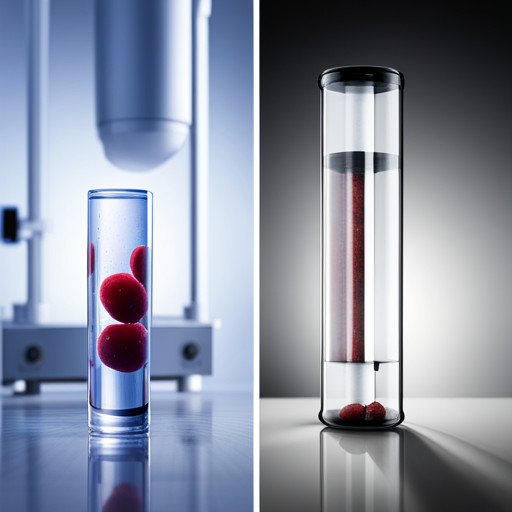Unveiling Links Between Leukemia and Toxic Water
The prevalence of leukemia, a malignant progressive disease, has seen a concerning rise globally. Concurrently, instances of water contamination are escalating, creating a toxic environment.

The article aims to explore the possible correlation between the two phenomena, their implications on human health, and potential preventative measures.
Detailed scientific analysis of water toxicity and its effects on leukemia development will be presented, along with a global perspective and future outlook.
Key Takeaways
- Leukemia is a malignant disease characterized by the overproduction of abnormal white blood cells and can be acute or chronic, requiring immediate treatment.
- Toxic elements in water, such as benzene, radon, and trichloroethylene, can cause DNA damage and disrupt hematopoietic function, increasing the risk of leukemia.
- Modern analytical tools and water filtration options like reverse osmosis and activated carbon filters can help detect and mitigate exposure to toxic elements in water.
- Preventive measures such as rigorous monitoring of industrial operations, stringent agricultural practices, regular testing of groundwater sources, and public education on water conservation and pollution prevention are essential to prevent water contamination and reduce the risk of leukemia.
Understanding Leukemia: A Brief Overview

Leukemia, a type of cancer that predominantly affects the blood and bone marrow, is characterized by the overproduction of abnormal white blood cells, which hampers the body's ability to fight off infections effectively. This pathological state is caused by damage to the DNA of blood cells, leading to uncontrolled cell division and growth. As a consequence, these abnormal cells usurp the space of normal cells, leading to the manifestation of lethal symptoms.
The progression of leukemia can be either acute or chronic. Acute leukemia is marked by the rapid multiplication of immature blood cells, necessitating immediate treatment. On the contrary, chronic leukemia progresses more slowly, allowing mature, but still abnormal, cells to accumulate over time. This classification is crucial in determining the urgency and course of treatment.
Treatment options for leukemia are multifaceted, often involving a combination of chemotherapy, radiation therapy, targeted therapy, and stem cell transplant. Chemotherapy exploits cytotoxic substances to kill cancer cells, while radiation therapy uses high-energy radiation. Targeted therapy, a newer field, involves drugs that target specific genetic changes seen in leukemia cells. Stem cell transplant aims to replace the patient's diseased bone marrow with healthy stem cells that can regenerate and produce normal blood cells.
Regular monitoring of the patient's health is vital to assess the effectiveness of treatment and adjust it accordingly. This includes blood tests, physical examinations, and occasionally, bone marrow tests. Ultimately, the objective is to achieve remission, wherein the signs and symptoms of leukemia are reduced or absent, improving the quality of life for the patient.
The Composition of Toxic Water

The investigation into the composition of toxic water necessitates a thorough examination of the methods used for identifying toxic elements. A critical appraisal of the various toxic elements, their properties, and the potential hazards they pose to health and the environment is paramount.
An analysis of the impact of dangerous chemicals is also essential. Understanding how these chemicals affect ecosystems, wildlife, and human health is crucial for developing effective mitigation strategies.
Additionally, a comprehensive assessment of the sources of toxic water is necessary. This includes an exploration of the diverse sources of water contamination, ranging from industrial waste to agricultural runoff. By understanding the different ways in which water becomes toxic, we can better address the root causes and prevent further contamination.
Overall, a holistic approach that combines the examination of identification methods, analysis of chemical impacts, and assessment of contamination sources is vital for understanding and addressing the issue of toxic water.
Identifying Toxic Elements
Identification of toxic elements in water sources plays a crucial role in understanding their potential link to leukemia. The incorporation of modern analytical tools has enabled precise detection of these contaminants.
Water filtration options, such as reverse osmosis and activated carbon filters, have been instrumental in mitigating exposure to these harmful elements. However, the persistent risk necessitates continuous advancements in both water purification technology and leukemia research.
The utilization of cutting-edge techniques in leukemia advancements, including genomic sequencing and targeted therapy, are vital in combating the disease. In parallel, innovative filtration methodologies are being explored to improve the removal efficiency of toxins.
Such integrated efforts are critical in addressing the potential health impacts of contaminated water.
Dangerous Chemicals Impact
Exposure to hazardous chemicals in water bodies has been linked with various health risks, including the increased incidence of specific types of cancers. The Chemical Exposure Consequences extend to chromosomal alterations, genotoxic effects, and oxidative stress, which potentially foster oncogenesis.
Studies have implicated toxins such as benzene, radon, and trichloroethylene in the etiology of leukemia. These carcinogens, once ingested or inhaled, can induce DNA damage, trigger inflammatory responses, and disrupt hematopoietic function.
Thus, mitigating these toxic exposures forms a vital part of Leukemia Prevention Strategies. This includes improved water treatment processes, stringent environmental regulations, public education on chemical hazards, and early detection of chemical contaminants.
Such multi-faceted approaches aim to reduce the burden of leukemia and promote public health safety.
Toxic Water Sources
Contaminated sources of water, including groundwater, industrial waste discharges, and agricultural runoff, present significant public health concerns due to the potential proliferation of hazardous chemicals. Such pollution sources can disseminate toxins that exacerbate the risk of developing diseases such as leukemia.
Municipal responsibilities are pivotal in managing this issue. Key mitigation strategies can be categorized as follows:
1. Rigorous monitoring of industrial operations to prevent and control toxic discharges.
2. Implementation of stringent agricultural practices to reduce hazardous runoff.
3. Regular testing of groundwater sources to detect contamination early.
4. Public education on water conservation and pollution prevention.
The Science Behind Water Contamination

The discourse will delve into the issue of water contaminants and their consequential effects, employing a scientific approach to understanding the characteristics and implications of diverse pollutants.
An in-depth analysis of various water testing methodologies will be undertaken, illuminating their respective merits and limitations within the context of detecting and quantifying these contaminants.
This exploration aims to enhance understanding of how scientific techniques are deployed in assessing water purity, elucidating the intricate relationship between water contaminants and their potential health and environmental impacts.
Contaminants and Their Effects
Research has shown a strong correlation between certain water pollutants and increased rates of leukemia. Furthering the understanding of this link requires a thorough examination of contaminants classification and water filtration techniques.
Four main types of water contaminants have been identified:
1. Physical contaminants, such as sediment or organic material.
2. Chemical contaminants, including elements or compounds like bleach, salts, and metals.
3. Biological contaminants, such as bacteria, viruses, and parasites.
4. Radiological contaminants, with radioactive material like uranium.
Each classification requires a distinct filtration technique to purify the water. Techniques range from distillation, activated carbon, to reverse osmosis. It is crucial to utilise the appropriate filtration technique for each contaminant class to ensure effective contaminant removal, thereby mitigating potential health hazards like leukemia.
Water Testing Methods
Various methodologies for testing water quality are essential in detecting and identifying the presence of the four main types of contaminants. These methods are often grouped into two categories: water filtration techniques and aquatic toxicity testing.
Water filtration techniques involve the removal of impurities from water by passing it through a physical barrier, chemical process, or biological process. On the other hand, aquatic toxicity testing measures the adverse effects of potential contaminants on aquatic organisms under controlled conditions.
| Testing Methodology | Purpose |
|---|---|
| Water Filtration Techniques | Removal of impurities |
| Aquatic Toxicity Testing | Measures adverse effects of contaminants |
Such methodologies provide valuable insights into the quality of water, thus aiding in the prevention of diseases such as leukemia, linked to toxic water.
Effects of Toxic Water on Human Health

Exposure to toxic water has been conclusively linked to a myriad of health issues, including serious conditions such as leukemia. The potential health effects are far-reaching, impacting both individuals and communities. High levels of contaminants in water sources can lead to chronic illness and can also exacerbate existing health conditions.
The implementation of hygienic practices and dietary changes can mitigate the impact of toxic water on human health. The following four strategies may be particularly effective:
1. Regular Hand Washing: This simple practice can significantly reduce the risk of ingesting waterborne pathogens, thereby reducing the likelihood of developing diseases.
2. Use of Filtered Water: As part of dietary changes, consuming filtered or bottled water can decrease exposure to harmful contaminants found in tap water.
3. Cleaning and Cooking Food with Filtered Water: This can prevent the ingestion of harmful toxins, thereby reducing the risk of illness.
4. Regularly Testing and Treating Household Water: This can help to identify and eliminate harmful elements in water.
The crucial importance of these strategies underscores the need for proactive measures to ensure the provision of clean water. It's not only a matter of preserving human health, but also of maintaining societal well-being and economic productivity.
Emphasizing preventive measures such as hygienic practices and dietary changes, along with regular water testing, can significantly reduce the burden of disease in communities at risk of exposure to toxic water.
Insight Into the Correlation Between Leukemia and Toxic Water

The correlation between leukemia and exposure to toxic water is a complex topic that warrants comprehensive analysis.
The influence of toxic water on the incidence of leukemia is not only a matter of public health concern but also a focus of significant scientific scrutiny.
Through utilization of robust correlation analysis techniques, this discussion aims to elucidate the intricate relationship between the toxicity of water and the prevalence of leukemia, thereby contributing to the body of knowledge in this critical area of research.
Leukemia: Toxic Water Influence
Research indicates a significant correlation between the incidence of leukemia and contaminated water, suggesting that toxic elements in water may contribute to the development of this disease. In relation to 'Leukemia Diagnosis, Patient Recovery', emerging data validate the detrimental impact of such pollutants on health outcomes.
1. Epidemiological studies demonstrate an elevated risk of leukemia in populations exposed to waterborne toxins.
2. Biochemical analysis reveals the carcinogenic potential of certain toxins commonly found in contaminated water.
3. Clinical records indicate a direct link between toxin exposure and the severity of leukemia prognosis.
4. Evidence from patient recovery patterns suggests that reducing exposure to contaminated water may significantly improve health outcomes.
Therefore, comprehensive understanding of the toxic water-leukemia axis is crucial for developing effective intervention strategies.
Correlation Analysis: Leukemia-Toxicity
Correlation analysis in the realm of leukemia-toxicity has further underscored the detrimental impact of water pollutants on health outcomes. Various studies have vividly elucidated the association between the exposure to toxic water and the onset of leukemia, revealing the potential role of genetic susceptibility in this equation.
Indeed, certain genetic alterations can exacerbate the vulnerability to these environmental toxins, consequently escalating the risk of developing leukemia. Consequently, alternative treatments that target these genetic vulnerabilities are being explored. Genetic modification therapies, for instance, may serve to fortify the genetic defenses against such environmental onslaughts.
Nevertheless, the primary objective remains the prevention and reduction of exposure to water pollutants to significantly curtail the incidence of leukemia.
Scientific Studies Supporting the Link

Numerous scientific investigations have provided substantial evidence supporting the link between leukemia and exposure to toxic water. These studies have illuminated the complex interplay of environmental factors, such as water toxicity, and biological predispositions that contribute to the onset of leukemia.
1. Leukemia Treatment Advances: Progress in medical science has enabled the development of targeted therapies for leukemia. These therapies aim to inhibit the growth of cancer cells by interfering with specific molecules needed for their proliferation. Advancements in chemotherapy drugs, immunotherapy, and stem cell transplantation have improved the survival rates of leukemia patients.
2. Genetic Predisposition Studies: Research has revealed the presence of certain genetic markers linked to an increased risk of developing leukemia. Individuals bearing these markers are more susceptible to the effects of environmental toxins, making them more likely to develop leukemia when exposed to toxic water.
3. Environmental Exposure: Studies have shown that prolonged exposure to toxic water, contaminated with hazardous substances such as benzene, radon, and arsenic, significantly increases the risk of leukemia. These toxins can induce harmful genetic mutations, leading to the formation of cancer cells.
4. Multifactorial Nature of Leukemia: Leukemia is a multifactorial disease, meaning that it is the result of a combination of genetic and environmental factors. The presence of a genetic predisposition alone does not guarantee the manifestation of leukemia. However, when coupled with toxic environmental exposure, the likelihood of disease onset dramatically increases.
Understanding the relationship between genetic predisposition and environmental exposure is critical for effective leukemia prevention strategies. Future research should continue to explore this interplay, aiming to reduce the incidence of leukemia.
Case Studies: Leukemia Patients and Toxic Water Exposure

Case studies involving patients with leukemia have shed light on the detrimental effects of prolonged exposure to water contaminated with hazardous substances. These studies have been instrumental in correlating enhanced risks of leukemia with regular consumption of or exposure to toxic water.
Scientific research has indicated a potential link between toxic water contaminants and the onset of leukemia, particularly in individuals with genetic predispositions. These predispositions often increase susceptibility to the damaging effects of toxic water, triggering the development of leukemia cells.
Over the years, advancements in leukemia treatment have played a significant role in managing these cases. Innovative methods, such as targeted therapy, immunotherapy, and stem cell transplantation, have improved survival rates. However, despite these advancements, the focus on prevention and early detection remains crucial. Understanding the environmental triggers, including water contaminants, can assist in formulating effective strategies to decrease the incidence of leukemia.
Furthermore, it has been revealed that the effects of toxic water contaminants can be exacerbated by certain genetic factors. These factors not only increase the likelihood of developing leukemia but also can impact the effectiveness of treatments. Thus, ongoing research efforts are exploring the interplay between genetic predispositions, environmental triggers, and leukemia treatment advancements in order to improve outcomes for patients with leukemia.
Possible Preventive Measures Against Toxic Water

Building on the evidence presented in case studies linking leukemia to toxic water exposure, the focus now shifts to potential preventive measures. It is of paramount importance to prioritise public health, and hence, comprehensive strategies need to be formulated and implemented.
These strategies can be broadly categorized into two areas: community awareness and filtration techniques.
1. Community Awareness: Public knowledge is a powerful tool in combating health hazards. By providing scientifically accurate information about the dangers of toxic water and its linkage to diseases like leukemia, individuals can make informed decisions about their water consumption. Awareness campaigns, workshops, and inclusion of this topic in academic curricula could be effective methods for disseminating this information.
2. Filtration Techniques: The advancement in technology has given rise to a plethora of filtration techniques. However, the adoption of these techniques is not universal. The reasons range from economic constraints to lack of awareness. Techniques such as activated carbon filtration, reverse osmosis, and distillation can significantly reduce the concentration of toxic substances in water.
3. Government Regulations: Strict regulations should be enforced on industrial waste disposal. Regular inspections and hefty penalties for violations could deter industries from polluting water sources.
4. Regular Monitoring: Constant monitoring of water sources can aid in early detection of contamination. This can be achieved through regular water testing in laboratories.
Current Challenges in Treating Water Contamination

Despite substantial advancements in filtration techniques, treating water contamination remains a formidable challenge due to factors such as high treatment costs, infrastructural inadequacies, and lack of stringent regulatory oversight. These treatment obstacles, coupled with existing regulatory loopholes in environmental protection laws, further compound the problem of water contamination.
The high costs associated with advanced water treatment methods often prove prohibitive, particularly for developing nations with limited resources. These costs encompass not merely the initial investment for treatment infrastructure, but also ongoing expenses for maintenance, personnel training, and waste disposal. Infrastructural inadequacies further exacerbate this issue. For instance, outdated or poorly maintained treatment facilities may fail to effectively remove contaminants, leading to compromised water quality.
Regulatory oversight in environmental protection plays a critical role in mitigating water contamination. However, the existence of regulatory loopholes often allows potential polluters to circumvent legal restrictions, contributing to the ongoing contamination of water resources. These gaps in regulation, whether due to vague wording, lack of enforcement, or exemptions for certain industries, can have severe implications for water treatment efforts.
Global Impact: Leukemia and Toxic Water Around the World

Global impact of polluted water on the prevalence of leukemia has been a topic of increasing concern in recent years, with numerous studies indicating an alarming correlation between the two. The severity of this issue is heightened by the increasing global statistics of leukemia cases and the subsequent need for effective leukemia treatment.
Scientific research has pointed to four main links between leukemia and polluted water:
1. The presence of industrial pollutants such as benzene and radon in water increases the risk of leukemia. These carcinogens, when ingested or inhaled, can cause damage to the DNA of cells, leading to leukemia.
2. Agricultural runoff, which often contains pesticides, herbicides, and fertilizers, can also contaminate water sources. These chemicals have been associated with an increased risk of leukemia, particularly in children.
3. Heavy metals like arsenic and lead, often found in contaminated groundwater, are known to increase the risk of leukemia.
4. Radioactive materials from nuclear power plants can contaminate water and increase the risk of leukemia.
The global statistics on leukemia cases have been steadily rising, with the World Health Organization reporting an increase of nearly 20% over the past decade. This increase underscores the urgent need for more effective and accessible leukemia treatment options.
However, the prevention of leukemia also requires a concerted effort to reduce water pollution. The toxic elements found in polluted water are not only a threat to health but are also a significant burden on the healthcare system. Therefore, tackling water pollution should be a global priority in the fight against leukemia.
Future Perspectives: Steps Towards Safer Water

Future perspectives on this critical issue necessitate a comprehensive examination of strategies for ensuring safer water, as this could significantly contribute to the reduction of leukemia risk worldwide. The potential role of advancements in water filtration systems and the impact of environmental policies are of particular interest.
Advanced filtration technologies, such as reverse osmosis and activated carbon, can efficiently remove contaminants from water. Moreover, nanotechnology-based filtration systems are receiving attention for their ability to eliminate even the smallest impurities.
Environmental policies play a pivotal role in water safety. Effective regulations on industrial waste disposal, water quality standards, and routine monitoring can significantly lower the levels of toxic substances in water, thus reducing potential health risks.
The table below presents a summary of the discussed strategies and their potential impacts:
| Strategies for Safer Water | Potential Impact |
| Advanced Filtration Systems | Efficient removal of water contaminants |
| Nanotechnology-based Filtration | Elimination of minute impurities |
| Industrial Waste Regulations | Prevention of toxic substance disposal in water bodies |
| Water Quality Standards | Ensuring the safety of drinking water |
| Routine Monitoring | Early detection and mitigation of water contamination |
Frequently Asked Questions
What Are Some Common Symptoms of Leukemia?
Common symptoms associated with leukemia include:
- Fatigue
- Frequent infections
- Unexplained weight loss
- Easy bruising or bleeding
These symptoms often prompt further investigation, utilizing leukemia diagnosis methods such as:
- Blood tests
- Bone marrow biopsies
Upon confirmation of leukemia, various treatment options are explored. These typically involve:
- Chemotherapy
- Radiation therapy
- Stem cell transplantation
- Targeted therapy
Each treatment option has varying degrees of success and side effects.
Are There Any Genetic Factors That Can Increase the Risk of Developing Leukemia?
Certain genetic factors may indeed increase an individual's risk of developing leukemia. Genetic counseling can help identify these risks by reviewing the individual's family health history. Additionally, mutation screening can detect any changes in genes that may predispose to leukemia.
Several inherited disorders and genetic mutations, such as Down syndrome or mutations in the TP53 gene, have been associated with an increased risk of this disease. However, the precise relationship between these genetic factors and leukemia risk remains an area of ongoing research.
What Are the Main Sources of Water Contamination Globally?
What are the primary global contributors to water pollution?
Industrial processes, agricultural runoff, untreated sewage, and improper waste disposal significantly contaminate water sources worldwide.
Preventing contamination necessitates the implementation of effective water purification techniques and stringent regulations governing waste management.
While these measures may not fully eradicate pollution, they can mitigate the detrimental effects on water quality, contributing substantially to global efforts towards safe and clean water accessibility.
Are There Any Other Health Conditions Linked to Exposure to Toxic Water Apart From Leukemia?
Exposure to toxic water has been linked to a myriad of health conditions beyond leukemia. This includes both acute and chronic diseases such as cholera, typhoid, and diarrhea, as well as longer-term conditions like liver damage and kidney failure.
Furthermore, according to the waterborne disease overview, neurological and reproductive problems can also be consequences of toxic exposure.
Therefore, ensuring clean water supplies is crucial for global public health.
How Is Water Contamination Being Addressed at Policy Level Worldwide?
Globally, water contamination is addressed through stringent policy enforcements and legal frameworks, which mandate the treatment and safe disposal of pollutants. The emphasis is on prevention, control, and remediation of water pollution.
There is also increasing global cooperation, with international treaties and conventions promoting shared responsibility and exchange of best practices for water management. This includes initiatives to upgrade technology for efficient water treatment, and strengthen monitoring and compliance mechanisms.
Conclusion
In conclusion, it is an irrefutable fact that the omnipresent issue of water toxicity is a global nemesis that is intricately linked with the surge in leukemia cases worldwide.
Undeniably, the pernicious effects of water contamination necessitate efficacious strategies for water treatment and leukemia prevention.
The importance of addressing this issue is as vast as the ocean itself, with the potential to affect the health of generations to come.

This post has been generated by AI and was not reviewed by editors. This is Not legal advice. Please consult with an attorney.




